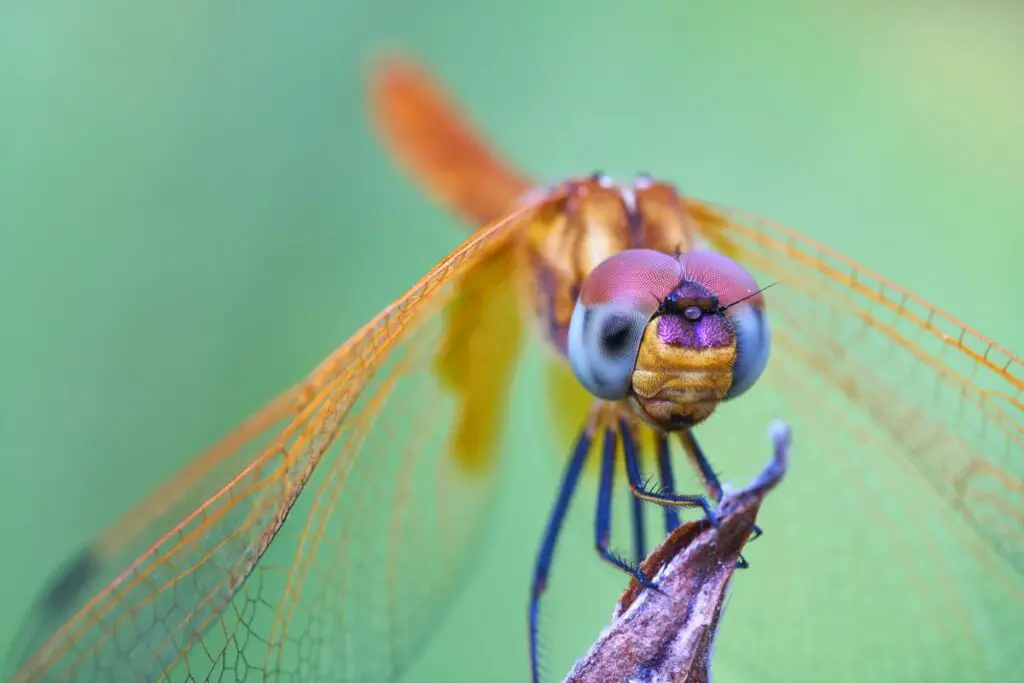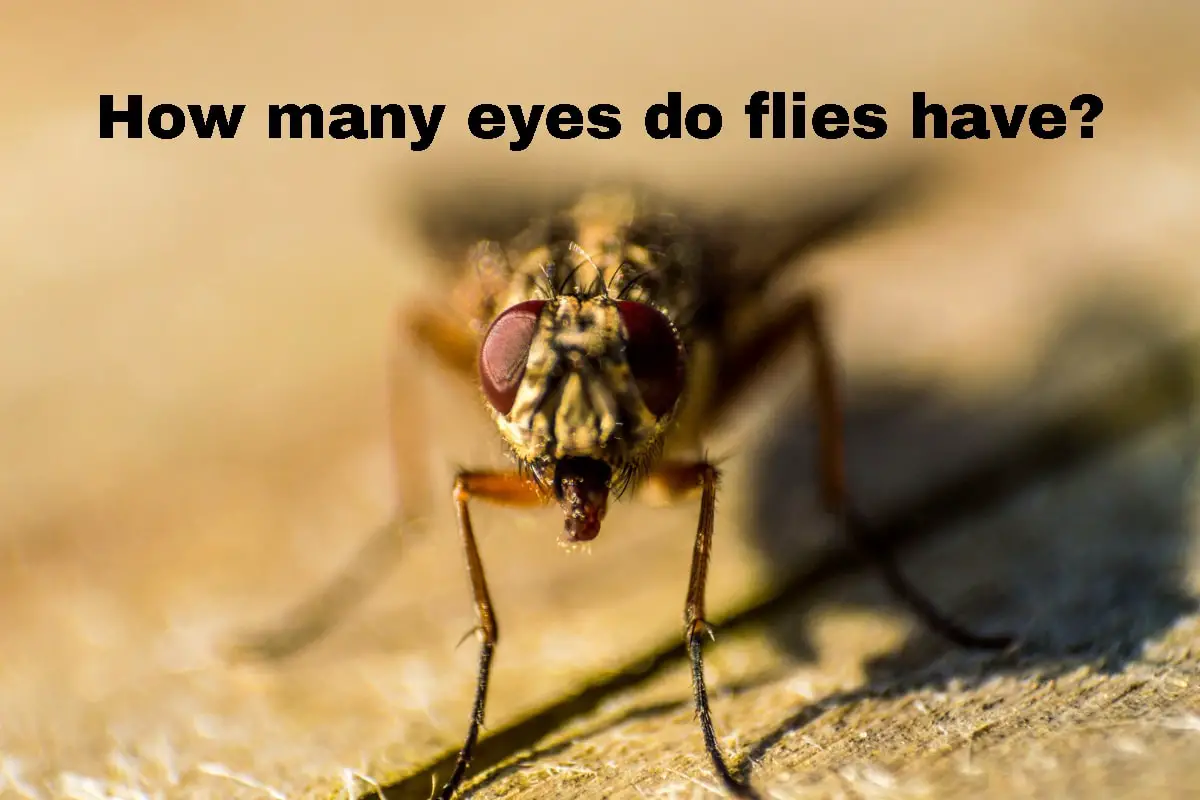Just about everyone in the world has seen, felt, or dealt with a fly at some point in their life. They buzz their way into our homes, narrowly escape our newspapers, and eavesdrop on our walls.
Flies may be annoying insects, but they are still creatures with amazing abilities. Besides being able to fly, they can also see almost 360 degrees. Let’s take a closer look at flies, how many eyes they have, and how their vision works.
How Many Eyes Does a Fly Have?
Flies have two large compound eyes and three simple eyes. The two large eyes are composed of hundreds to thousands of small units or lenses, called ommatidia. The simple eyes, known as ocelli, detect motion and light, helping the fly navigate.
Even though you could say that flies have thousands of small eyes, have almost 360-degree vision, and have other simple eyes to help detect movement, they still do not have the best vision. This is why you see them bumbling around.
So, you may ask yourself, why do flies have so many eyes? The number of eyes a fly has is not the critical part. It’s how these compound eyes converge different images together to display one image that is the most interesting.
Does a Fly Have a Thousand Eyes?
This question comes up quite a bit and it’s not surprising, because, with the dynamics of a compound eye, you could certainly conceive that a fly could have a thousand eyes.
The compound eyes on a fly are made up of many small lenses, they can be numbered in the hundreds and even in the thousands, depending on the type of fly that you were examining.
However, they do not make thousands of tiny complete images, instead, they combine to make one image that the fly sees. This means that even though they may have thousands of tiny lenses, they only see one image.
5 eyes on a fly:
- 2 compound eyes
- 3 simple eyes
Although compound eyes are made of many lenses, they are still considered one individual eye. So a fly technically has 5 total eyes, 2 compound eyes, and 3 simple eyes and they can only see a visual out of the two compound eyes.

Does a Fly Have 3 Eyes
A fly has 3 simple eyes, besides its two compound eyes. What are simple eyes? Simple eyes on a fly do not see vision, instead, they sense movement and light. They are three small bumps that are located in the middle-top between the two compound eyes.
The 3 simple eyes on a fly are made up of one lens each. These three lenses can sense changes in light, quickly, giving them the advantage of fast movement and reaction time.
Many other insects have these simple eyes, because when an insect is flying around it helps to have more than just a visual, sensing movement, and light gives them quicker reflexes that help them avoid getting swatted!
What Does a Fly’s Vision Look Like
With so many eyes, it’s a wonder how they got such a short end of the stick-on vision. Their eyes see almost 250 flashes per second, which is many times faster than the rate that a human sees.
This is why they can fly away before you can swat them because their response and reaction time are 4 times faster than a human.
Even still, they are short-sighted and can only see a couple of yards in front of them. Many small images come together to form their vision and it can be a little blurry.
Flies do not see a full range of colors. They cannot tell the difference between some colors, such as yellow and white.
Want to learn more about cool animals? Check out Otter Dens – Things You Otter Know

How Smart are House Flies
House flies are often considered to be smart because many times they are able to avoid being swatted and killed by reacting faster than we do. They are able to process more frames per second.
In fact, the human eye processes around 60 frames per second, while a fly’s eyes can process 250 frames per second. Impressive!.
Flies do not have pupils like humans, the pupil helps restrict the amount of light that goes into the eyes.
So even though they process faster, they still have trouble seeing shapes and sharp images. Are they smart? They are smart enough to exist and keep existing. Are they smarter than humans? No.
If you like this article, check out Are Salamanders Poisonous
What Color Do Flies Hate?
Many people suggest that flies hate the color yellow. This is why many bug lights are a yellow color. Red can also be a color that has a minimal impact on attracting flies. Do flies hate the color red? Probably not, but they are less attracted to it than white or yellow.
Colors are important when it comes to vision. With flies, there are certain colors that they cannot differentiate between. The eyes of a fly are often a darker color because of the dark pigments that the lenses are made from.
Flies only have two photoreceptors, only allowing them to process light into two colors. House flies can only see green and blue, or ultraviolet and green.
How Many Eyes Does a Dragonfly Have
Dragonflies come in many sizes and in many colors. They are beautiful insects that inspire the imagination.
Dragonflies have two compound eyes and three simple eyes. The difference between eyes, in different types of flies, is usually found in the number of ommatidia, or the number of lenses that make up the compound eyes.
The eye colors can also be very different. House flies have eyes that appear dark red, or a dark color, while some dragonflies have green and blue hues to the color of their eyes.

What Color do Flies Love?
Although you may get mixed answers to this, the latest information that I have found is that flies are attracted to the color blue.
In fact, researchers at the University of Florida have found that the color blue attracts flies in devices that catch flies more than the color yellow or white. Their studies showed that flies are 3 times more attracted to blue than yellow.
Love animals as much as we do? Check out some of our favorites:
Conclusion
While it may seem like there are many answers to this question, I think it can be summed up as simple as this, flies have two compound eyes and three simple eyes.
Even though the compound eyes make up many small pieces of an image, together they make only one image. This is like a mosaic effect. The simple eyes may only detect light and motion, but that can still aid them in their overall vision and navigation.
- Hero Farm Dog Survives Epic Battle with Coyote Pack - December 9, 2024
- The 10-Minute Bedtime Routine That Changed My Dog’s Sleep Forever - November 29, 2024
- Creating a Safe Space for Nervous Pets: Your Guide to Pet-Friendly Havens - November 25, 2024

